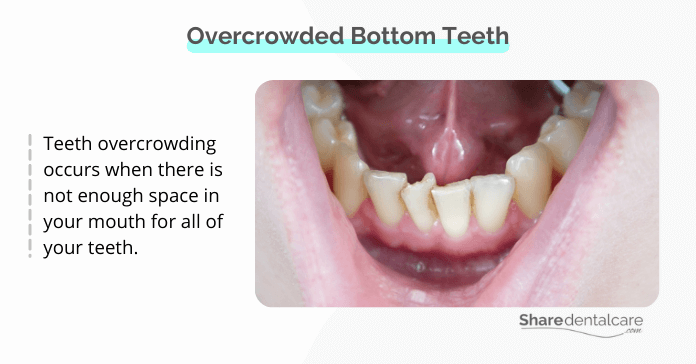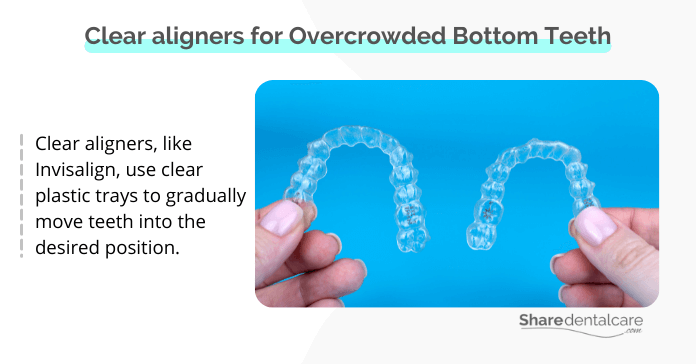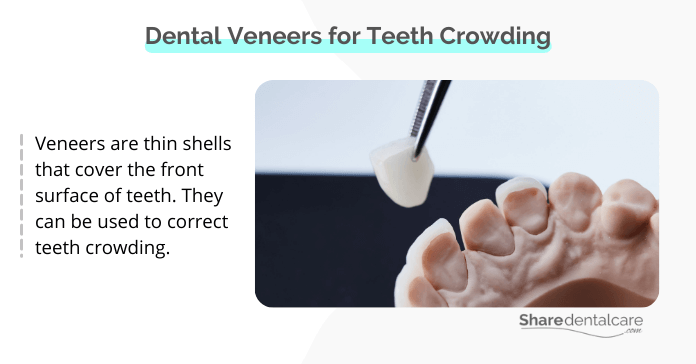Our teeth are one of the most important parts of our body. Not only do they help us chew and eat, but they also play a major role in our appearance. That’s why it can be so frustrating when we experience problems with our teeth, such as overcrowded bottom teeth. Teeth crowding can make it difficult to chew and eat properly, and it can also make your smile look unattractive. Keep reading to learn more about overcrowded teeth and the treatment options available.
What are Teeth Overcrowding?
Teeth overcrowding is a type of dental malocclusion (misalignment) that occurs when there is not enough space in your mouth for all of your teeth. As a result, your teeth may start to grow or erupt in improper positions. Overcrowded teeth can be upper teeth, lower teeth, or both.
Causes of Overcrowded Bottom Teeth
There are a number of reasons for overcrowded bottom teeth. The most common causes of overcrowded bottom teeth include:
- Genetics. If your parents or grandparents had overcrowded bottom teeth, you are more likely to have this dental condition.
- Poor oral habits. Thumb sucking or tongue thrusting habits can put pressure on teeth and cause them to become overcrowded.
- The early loss of baby teeth. When baby teeth are lost too early, there is not enough space for the permanent teeth to come in properly. So, teaching dental hygiene to preschoolers is essential to prevent the early loss of baby teeth.
- Prolonged use of a pacifier or baby bottle. If your child uses a pacifier or bottle for an extended period of time, it can cause their teeth to become overcrowded.

Other possible causes
- Jaw Size. If you have a small jaw, this can cause overcrowding of your bottom teeth.
- Enlarged Teeth. If your teeth are larger than normal, they may overcrowd your mouth.
- Extra teeth. If you have more teeth than normal (supernumerary teeth), it can cause overcrowding.
- Misaligned jaws. If your upper and lower jaws are not aligned properly, it can crowd your teeth.
- Injury to the mouth or jaws. This can damage the teeth and cause them to grow or erupt in improper positions.
- Gum disease. Periodontitis, a severe form of gum disease, can damage the bones and tissues that support the teeth. This can cause your bottom teeth to become loose and overcrowded.
- Tumors or cysts in the mouth. They can crowd the teeth and cause them to erupt in improper positions.
The Effects of Overcrowded Bottom Teeth
Teeth overcrowding can lead to several oral health issues, such as:
- Tooth decay. When bottom teeth are overcrowded, it is difficult to brush and floss properly, which can lead to tooth decay.
- Gum disease. Because overcrowded teeth are difficult to clean properly, plaque and bacteria can build up and cause gum disease.
- Jaw pain. Misaligned teeth can put pressure on the jaw, which can cause jaw pain and TMJ disorders.
- Lower your self-esteem. Misaligned bottom teeth can make you self-conscious about your smile and affect your quality of life.
Treatment Options for Overcrowded Bottom Teeth
If you have overcrowded bottom teeth, there are several treatment options available. The most common treatments include:
Braces
Braces are the most common treatment for overcrowded bottom teeth. They can help to align your teeth and create more space in your mouth. Braces consist of metal brackets that are attached to your teeth and a metal wire that is threaded through the brackets. The wire is adjusted periodically to move your teeth into the correct position. It can take from 1 to 3 years to correct misaligned teeth with braces.

Clear aligners
Clear aligners, like Invisalign, are orthodontic devices that are made from clear plastic. They are less visible than traditional braces. Clear aligners are custom-made to fit your teeth and can be removed for eating and brushing. They are worn over your teeth and gradually move your teeth into the correct position.
You need to wear clear aligners for at least 22 hours a day to achieve the desired results. Clear aligners are not recommended for severe overcrowding. You can read more about Invisalign for bottom teeth crowding.

Veneers
Veneers are a thin layer of porcelain that is bonded to the front of your teeth. They can be used to correct several dental problems, including overcrowding. Veneers are a popular choice for people who want to improve their smile but do not want to wear braces.
Veneers can be expensive and may require additional dental work to prepare your teeth for the veneers. They usually last between 15 and 20 years. Veneers are recommended for people who have mild overcrowding. You can read more about veneers for overlapping teeth.

Surgery
If overcrowding is severe, your dentist may recommend surgery to correct the problem. Surgery can involve moving teeth to the correct position or removing teeth. It is a more invasive procedure than braces or clear aligners and may require a hospital stay. Surgery is usually the last resort for bottom teeth overcrowding.
Overcrowded Bottom Teeth – Conclusion
Overcrowded bottom teeth can lead to several oral health issues, such as tooth decay, gum disease, and jaw pain. There are several treatment options available, including braces, clear aligners, and veneers. Each treatment has its benefits and drawbacks. Therefore, it is important to consult with your orthodontist to find the best treatment for you.